One month ago I sowed most of my Lophophora seed for this season and thought I would post some pictures of the minuscule seedlings, only a couple of weeks old.
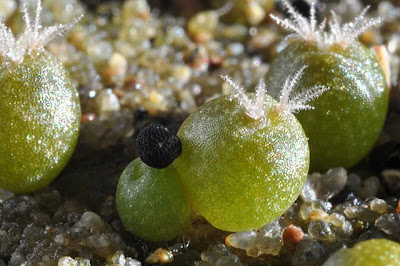
Lophophora williamsii seedlings (VM 534k; El Oso, Coahuila, Mexico)
I again bought seeds originating from the L. williamsii population in El Oso, Coahuila as I'm fascinated with the plants described in the booklet The genus Lophophora – Kaktusy Special 2, 2005 - allegedly this variety forms massive clusters with individual heads measuring up to 15 cm in diameter. The two seedlings in the center front of the above photo have grown from the same seed.

Lophophora decipiens sensu Steven Brack
For a long time I have wanted to grow the Lophophora decipiens offered in the Mesa Garden seed catalog – the plants are alluringly described as “powdery grey”. I have started L. decipiens seeds from Mesa Garden once before but ended up killing off most of the seedlings – to be on the safe side I ordered 100 seeds this time and are going to start them in several, separate batches ;-)
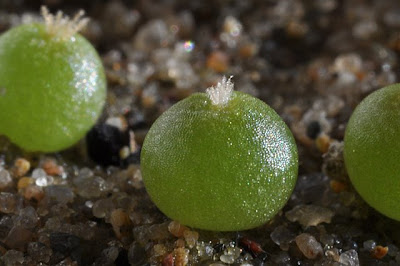
Lophophora fricii seedlings (KS 198; Viesca, Coahuila, Mexico)
I'm growing increasingly enchanted with Lophophora fricii but don't really have any mature specimens of this interesting species (except one plant that is almost of flowering size). To amend this I'm starting batches of Lophophora fricii from seed on a regular basis.
.jpg)
Lophophora williamsii seedlings (SB 418; Presidio County, Texas)
The L. williamsii plants from Presidio County, Texas represent the northernmost form of L. williamsii, also known as Lophophora williamsii var. echinata, and is a self-evident candidate for growing in the coldhouse.
Tuesday, May 12, 2009
Lophophora seedling pictures
Thursday, April 23, 2009
Spring awakening in the coldhouse
All of the photos in this post were taken at the beginning of April to illustrate some of the spring activity in my coldhouse. The plants have been kept dormant all through winter and received their first drink of water only a few days before these pictures were shot.
Flowering Lophophora williamsii (El Huizache, San Luis Potosí)
The first plant I want to show off is a flowering Lophophora williamsii grown from seed originating from the El Huizache, San Luis Potosí, Mexico population (the population Anderson assigned as the neotype for the species). These plants are from a more southerly location than the ones I'm usually growing and I'm happy to see they are coping so well with the cold conditions during winter. I was getting used to thinking of all L. williamsii varieties as self-fertile but according to the Cactus Conservation Institute, greenhouse breeding experiments by Bohata and colleagues in the Czech Republic and by Köhres in Germany have shown that plants from the El Huizache population are self-sterile and therefore obligate outcrossers (leading one to suspect a great deal of genetic diversity within plants from this population – in contrast to the self-fertile populations that have little to no genetic diversity among individuals as they outcross very little). 
Lophophora williamsii (El Huizache) flower with long style
The flowers of the El Huizache plants also seem to have a very long style that raises the stigma well above the stamens, making it hard, if not impossible, for the plants to reproduce without the help of a pollinator.
Bumble bee having fun with a Lophophora williamsii flower
Speaking of pollinators a bumble bee visited while I took these pictures – unfortunately only this one Lophophora flowered at the time making it impossible for the bee to fertilize the plant. The bumble bees that are active in early spring are huge; I don't know much about bees but am told that these large slow individuals are queen bees looking for nectar and pollen to feed their newly hatched brood.
Lophophora williamsii (SB 854; Starr Co, Texas) with fresh fruit
One of the Lophophora williamsii (SB 854; Starr Co, Texas) plants that I recently repotted has spawned a fruit. This variety of Lophophora williamsii is self-fertile to an extent where it happily sets seed if you just shake the flower a bit.
Flowering Acharagma roseana (LX 578; Ramon Arizpe, Coahuila)
My Acharagma roseana plants (LX 578; Ramon Arizpe, Coahuila - “Ramon” should probably read “Ramos” but I'll stick to the information from the vendors seed list) are coming of age. The plants were started from seed 4 years ago and are all ready to flower, displaying a wealth of flower buds. Only one, shown in the picture above, flowered when I took the pictures. Unfortunately it will be a while before I can visit my summerhouse (and coldhouse) again – I hope at least a few of the flowers will be saved for then. My Echinocereus reichenbachii plants are also growing a multitude of buds, getting ready for a flower fest I would hate to miss.
Frost damaged Matucana madisoniorum
Until now I have focused entirely on the success stories but a few of my plants didn't like being without heat during winter. My Matucana madisoniorum definitely didn't like the cold conditions (even being wrapped in multiple layers of horticultural fleece). The plant is heavily marked by the experience but survives.
I also lost a few plants: a couple of Carnegia gigantea (saguaro cactus), a Cylindropuntia bigelovii (teddy-bear cholla), and a Cylindropuntia tunicata (thistle cholla); I managed to save cuttings of the chollas though. These plants were kept out on the terrace all summer and I probably left them out for too long, exposing them to the autumn storms so the plants were not able to dry out completely before winter. I'm especially sad about the Carnegia gigantea plants as they were great specimens and are now completely reduced to mush.
Tuesday, April 21, 2009
The power of grafting – 5th anniversary
Five years ago today, I grafted a tiny Lophophora williamsii (SB 854; Starr Co, Tx) seedling onto a robust Trichocereus pachanoi stock. The Lophophora scion has since grown considerably – the main head is approximately 8 cm (~3.2'') wide; the total width including the offshoots now exceeds 14 cm (~5.5'').

Lophophora williamsii grafted onto Trichocereus pachanoi stock
This growing season the plant hasn't flowered yet but one of the “pups” (new offshoot stems) will do so within days as is evident from the next picture.

Flower bud and red spider mites
Unfortunately not only the plants are returning to life after their winter hibernation – the dreaded red spider mites are also fully active again (you should be able to spot at least four mites in the photo above) so the fight is on once more.
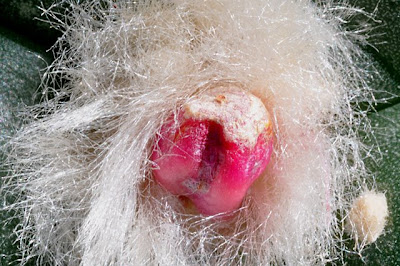
Ripe Lophophora williamsii fruit
Even though most of last year's fruits have long since ripened (and been harvested) the odd fruit is still showing. A plant this size gives hundreds of seeds each year making it a virtual seed “factory”.

Lophophora williamsii - rib count increasing?
The plant seems set on increasing its rib count beyond 8 – if I'm lucky it will not be content with growing just a few more ribs but go straight for the next number in the Fibonacci sequence, 13. The more ribs the merrier as it means more areoles and consequently more flowers and seeds.
The main head of the grafted Lophophora williamsii has grown 14 pups (15 if you also count a pup's pup – I guess you could call that a grandpup ;-) and has reached a size where it needs to be repotted soon.
For comparison you can check the posts on the same graft as one, two, three, and four years old.
Friday, October 03, 2008
How soon after your Lophophora flowers can you expect a fruit?
I was asked this question in a comment a while ago. I could not give an answer that was more precise than flowers pollinated early in the growing season would set fruit later the same year so I decided to investigate the question further. 
Freshly pollinated flowers marked with yellow cotton
Friday July 18 I marked 5 freshly pollinated flowers on my grafted Lophophora williamsii (SB 854; Starr Co, Texas) with yellow pieces of cotton - the cotton was attached to the spent flowers using nail polish. The flowers were all pollinated 1 and 2 days prior to being marked.
All I had to do now was lean back, relax, and wait for the fruits to pop out.
Wednesday September 10 – less than 8 weeks after pollinating the flowers – all 5 fruits had appeared.

Lophophora williamsii fruits

Lophophora williamsii fruit up close
The first fruit (in the right hand side of the photo below) appeared more than a week earlier than the others and consequently looks a bit withered.
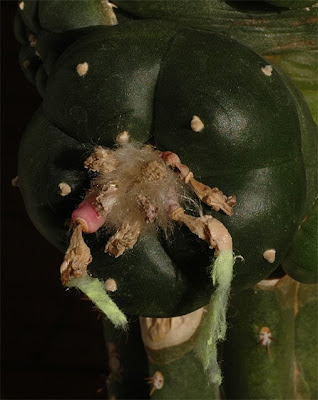
Offset with fruits

Another offset with fruit
So a more precise answer to the question above is that you can expect your Lophophora williamsii plant to set fruits within 7-8 weeks after pollination. At least that is the case for a grafted plant in good growth.
Monday, August 11, 2008
Coldhouse grown Lophophora williamsii - the next generation
Four years ago I started my first batch of coldhouse grown Lophophora williamsii (SB 854; Starr Co, Texas) from seed. I've lost a few plants to frost during the years but the survivors have coped surprisingly well, enduring the Danish winters in an unheated greenhouse without problems (that being said, I still worry a bit for the plants every winter ;-).
Flowering Lophophora williamsii (SB 854; Starr Co, Texas)
The plants are now old enough to flower and have been doing so freely all summer. The above photo was taken late June and today the plants are still flowering.
I have pollinated as many flowers as possible - if more plants flower at the same time the flowers are cross-pollinated, otherwise selfed. A cotton-tipped swab can be used for transferring the pollen from the anther and deposit it on the stigma.
Lophophora williamsii pollinated with the help of a Q-tip
Lophophora williamsii with pollen deposited on the stigma
The plants have already set the first fruits (the picture below was taken at the end of July) - I can't say if these fruits are the result of the flowers being pollinated 5 weeks before, but I'm currently conducting some experiments to get a better understanding of how much time passes between a flower is pollinated and the resulting fruit appears.
Fruiting Lophophora williamsii
As mentioned above I cross-pollinate my Lophophora williamsii plants when possible (I don't cross plants from different locations though). This might be a waste of time as preliminary studies by Martin Terry indicate that outcrossing is close to zero (i.e. selfing is virtually 100%) in natural populations and all individuals in a given population are clones. The study is based on data from three Texan populations, including Starr County, and the results are not definite - but if the results are correct it would also mean that my surviving (Starr County) plants are not more fit for the coldhouse, genetically speaking, than the ones that died off as they are/were all clones... and I thought I was witnessing a live "selection of the fittest" drama. Anyway, I'll harvest the seed soon to start the next generation of coldhouse grown Lophophora williamsii ;-)
----------------------
Read the comments for a discussion on the use of the word "clone".
Sunday, July 20, 2008
New plants for the coldhouse
Last week I received a new batch of plants from Kakteen Kliem. The plants are going to live in my coldhouse so I selected plants originating from habitats where they are naturally exposed to frost - I hope this also gives them the ability to withstand the freezing conditions they have to endure during winter here in Denmark. 
Lophophora williamsii (JJH 8608293; Pecos River, Texas)
I already have several of these Trans-Pecos Lophophora williamsii plants but decided to procure a few more as Kliem’s stock is running low.
Ariocarpus fissuratus (SB 403; Crockett County, Texas)
My few coldhouse grown Ariocarpus fissuratus plants have all survived until now so I felt like adding some more to the collection ;-)
Homalocephala texensis (DJF 891.3; Yoakum County, Texas)
Homalocephala texensis (aptly named the “Horse Crippler”) is a first for me - I’m looking forward to watching these plants grow and develop their characteristic heavy spine armor.
Normanbokea valdeziana (SB 1468; Ramos Arizpe, Coahuila, Mexico)
Normanbokea valdeziana is another first. I’m not quite sure what to expect from these plants but I fell for their fuzzy looks and beautiful flowers.
As always Gerhard Kliem’s plants are of an excellent quality.
Wednesday, May 14, 2008
Lophophora flower fest
Several of my plants are flowering right now, including many of the large undetermined Lophophora plants I bought earlier this spring. The plants were sold as Lophophora williamsii but body morphology and flower color suggest that many of them are actually Lophophora diffusa. Even though they flower, it is still difficult to determine the species of some of the plants conclusively, so I suspect them to be of hybrid origin. A handful of flower photos are included below.



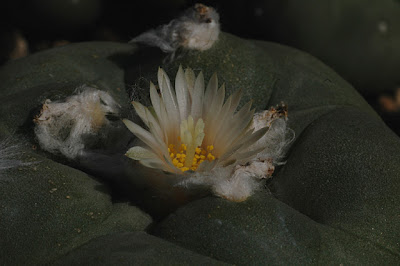

Sunday, May 04, 2008
Time-lapse video of a flowering Lophophora williamsii
I've been away on a short vacation and it seems my grafted Lophophora williamsii (SB 854; Starr Co, Tx) has spent its "lone time" wisely and grown three flowers.
Lophophora williamsii displaying three flowers
Even though the flowers were already quite open when I returned home, I decided to attempt a time-lapse video showing the flowers open fully. Unfortunately I forgot to disable the cameras autofocus function which gives the video a shaky appearance as the camera continuously changes focus slightly.
That being said, I'm impressed by the agility of the Lophophora stamens - they seem almost to be dancing around the style. A dazzling display of thigmotropic behavior is shown 50some seconds into the video; the stamens are disturbed and fold rapidly in around the style only to resume their perpetual wiggle shortly after. In contrast to this Epithelantha micromeris v. greggii stamens never seem to move during flowering.
I yet haven't managed to create a time-lapse video that is fully satisfying (the flower must be shown from bud to full bloom, the image must not shake/autofocus, no drop outs must occur in the stream of images, etc). I'll keep trying though, but I'll bet that when everything is set for the perfect time-lapse the shutter of my good old D70 gives up the ghost just before the shoot is finished ;-)
The photos for the time-lapse were shot at intervals of 15 seconds during a period of 160 minutes. The pictures are played back at a rate of 10 frames per second, i.e. the flowering is speed up by a factor of 150 resulting in a video running for 64 seconds.
Monday, April 21, 2008
The power of grafting – 4th anniversary
Four years ago today, I grafted a tiny Lophophora williamsii (SB 854; Starr Co, Tx) seedling onto a robust Trichocereus pachanoi stock. The Lophophora scion has since grown to a width of 8 cm (~3.2'') and set 6 offshoots - the total width including the offshoots exceeds 13 cm (~5.1'').

Grafted Lophophora williamsii (SB 854; Starr Co, Tx)
The plant flowered throughout summer last year and many of the resulting seed pods are ready to be harvested. This season's first flower already appeared last week and the remains can be seen in the photo below.
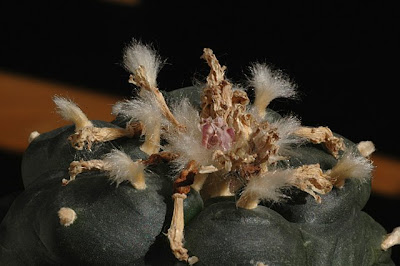
Lophophora williamsii - ready for seed harvest
Last year's flowers were allowed to self-pollinate with minimal human intervention. Today I harvested all freely exposed fruits and left the rest to fully mature. So far the result seems good as the plant set a lot of seed, time will show if it is viable.

Dried Lophophora williamsii fruit
Many of the fruits have a dry and brittle husk that is easily ripped and some of them almost spilled open when harvested. I probably ought to harvest the seeds sooner and not allow the fruits to sit and dry on the plant for too long.

Ripped Lophophora williamsii fruit with seeds exposed
As mentioned the plant has set lots of (selfed) seeds: the initial harvest totalled 101 seeds and there are still a few fruits left on the plant to be harvested later.

101 home grown Lophophora williamsii seeds
For comparison you can check the posts on the same graft as one, two, and three years old.
Saturday, April 05, 2008
Starting Pelecyphora and Lophophora from seed, 2008
Yesterday I started this year’s first batch of seed. I’m usally sowing my cactus seeds at the beginning of March, but I’ve been otherwise occupied so I had to start a bit later than usual. 30 seeds each of the following species were sown:
- Lophophora williamsii (SB 418; Presidio County, Texas)
- Pelecyphora aselliformis (MMR 111.1; El Pedernal, San Luis Potosí, Mexico)

Lophophora williamsii, Shafter, Presidio County, Texas (photo from http://lophophora.info/)
I’ve been looking for L. williamsii originating from the Trans-Pecos region of Texas for a while, so I was pretty exited to find the SB418 seeds from Presidio County, Texas. I’m looking forward to see how these plants develop (and also bought a batch of these seeds to start in my coldhouse).

Pelecyphora aselliformis in habitat (photo from http://www.cact.cz/)
Pelecyphora aselliformis is a first for me. I’ve always wanted to grow this distinctive species but for some reason never got around to it until now.
The seeds were started as described in the post on growing cactus from seeds and are bought from Jan Martin Jecminek.
Most of the seeds I’m growing this year have been selected for their (alleged;-) cold hardiness and will be sown later in my unheated greenhouse.
Update - April 12, 2008
Prompted by Patrick's comment I decided to include more detailed information on how the germination progresses. 5 days after sowing the seeds one Lophophora and 8 Pelecyphora seedlings had germinated (L=1/P=8). After 6 days the numbers were L=6/P=14, after 7 days L=13/P=17, and today (day 8) L=15/P=20. This means that after 8 days the germination rates for the Lophophora and Pelecyphora seeds are respectively 50% and 67%.
Update - April 25, 2008
April 19 the germination numbers were L=16/P=24, on April 22 the Lophophora germination count had risen to 19, and today April 25 the counts still are L=19/P=24. So after approximately 3 weeks the germination rates for the Lophophora and Pelecyphora seeds are respectively 63% and 80%. It should be mentioned that one of the Lophophora seedlings died off but is still included in the germination count (as it actually started growing but didn't make it from there).
Sunday, March 30, 2008
Lophophora - experiments in cold hardiness, 2008
As mentioned in the previous post on Ariocarpus and Epithelantha I have experimented with coldhouse grown Lophophora since 2004.
Lophophora williamsii (SB 854; Starr Co, Texas), 2004
The Lophophora williamsii (SB 854; Starr Co, Texas) plants from the 2004 batch are still doing great. The plants are growing true to the type with a glaucous bluish-green epidermis. The one on the left flowered last year so I'll soon be able to produce seeds originating from plants that have survived several seasons in an unheated greenhouse. During winter all my Lophophora plants are wrapped in horticultural fleece - both as a protection against the cold but also to keep out hungry pests.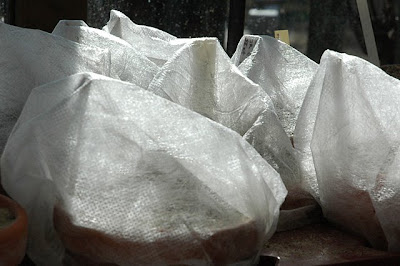
Lophophora plants wrapped in horticultural fleece
Some of the plants needed to be repotted before the upcoming growing season, for example these Lophophora williamsii (SB 854; Starr Co, Texas) plants from the 2005 batch.
Lophophora williamsii (SB 854; Starr Co, Texas), 2005
The plants started from seed in 2005 have grown to 2.5 - 3 cm (~ 1'') in diameter - with a bit of luck they might flower already this summer.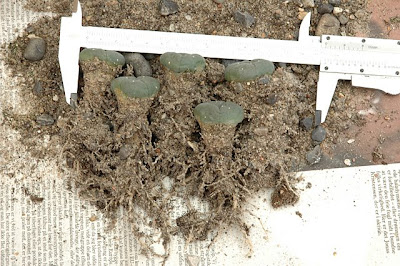
Uprooted Lophophora williamsii (SB 854; Starr Co, Texas), 2005
I never cease to be marveled by how large a fraction of a Lophophora plant that is actually growing underground. The plant pictured below has a crown that is approximately 1 cm high while the massive part of the taproot amounts to 4 times that and the full root system is more than 10 cm long.
Lophophora williamsii (SB 854; Starr Co, Texas) with exposed root, 2005
The past winter was mild - the coldest temperature registered inside the coldhouse was -5C (23F) - so even my Lophophora diffusa and Lophophora decipiens plants have all survived without any signs of damage. 
Lophophora diffusa (Higuerillas, Queretaro, Mexico)
The Lophophora decipiens plants are very shriveled and look in dire need of a drink of water. They'll have to wait for a couple of more weeks in order for the weather to warm up.
Shriveled Lophophora decipiens
Last year I grafted a handful of Lophophora williamsii (SB 854; Starr Co, Texas) seedlings on frost hardy Opuntia compressa (Monmouth County, New Jersey) stock. The grafts seem to be doing well and I'll get back with more information on Opuntia grafting when I've done some more experiments.
Lophophora williamsii (SB 854; Starr Co, Texas) grafted on Opuntia compressa stock
Monday, March 24, 2008
Lophophora bargain
When visiting garden centers and flower shops I'm always checking out their cacti and succulents to see if they have any interesting plants. Usually they don't. This Easter my girlfriend and I were browsing a garden center looking for common hollyhock (Alcea rosea) to plant at our summerhouse when I eyed a trayful of Lophophora plants.
Six large Lophophora plants
The plants are quite large, 7.5 - 8 cm (~ 3'') in diameter, and are looking a bit bloated; they don't have the ancient, mature look and feel you would normally expect from plants this size.
Lophophora 7.5 cm in diameter
Despite their youngish appearance the plants are old enough to be sexually active (many have flower remains peering out of the wool).
Lophophora with flower remains
I don't think the garden center exactly knows what they are selling. The plants are mislabeled as "Lophophera williamsii" and when asked the people at the center had no idea where the plants were produced. Maybe that's why the plants are sold dirt cheap at 35 DKK apiece (approximately 7 USD or 4.5 EUR). Anyway, I ended up buying 9 plants and even though they are allegedly Lophophora williamsii I'm pretty convinced there's at least one L. diffusa among my plants.
Root-bound Lophophora cactus
The plants are extremely root-bound and growing in a peat based soil with (what looks like) blackish lava granules in the mix. After carefully removing the plants from their pots they were left to dry for a couple of days before being repotted.
Four of the plants will probably end up in my coldhouse, and I'm planning to dissect one of the plants to study its anatomy. She who must be obeyed is particularly fond of the last idea - she's already bitching about where to find room for all my new plants ;-)
You can see photos of some of the plants flowering in this post.
All Time Most Popular Posts
-
On various occasions I've been asked what growing media I'm using for my cactus plants. I don't have a set soil mix recipe as su...
-
Lophophora williamsii (peyote) populations have diminished in large areas of South Texas where peyoteros harvest the cactus for ceremonial ...
-
Below is a list of retailers/nurseries selling cactus seed and plants. I've only listed vendors I've done business with. If you ar...
-
Most cacti are easily grown from seed - and with a little patience and care they can be grown into beautiful plants. Lophophora williamsi...
-
In last month’s post on the troubled Texan peyoteros I referred to Anderson’s article on the peyote situation in Texas. Given the importanc...
-
Yet another slightly off topic and probably not entirely politically correct post, but I couldn’t help noticing the similarity of my monstr...
-
Flowering stand of San Pedro cacti (Trichocereus pachanoi) To me the main draw of the San Pedro cactus ( Trichocereus pachanoi (syn. Ech...
-
In the June 2008 issue of the Cactus & Co magazine Jaroslav Šnicer, Jaroslav Bohata, and Vojtěch Myšák described a new Lophophora spec...
-
There seems to be an increased focus on the alarming Texas peyote situation. A couple of weeks ago the Houston Press published a mournful, i...
-
I spent two weeks working in Delhi, India during January. I had one weekend off and had planned to spend it in Delhi at my own leisure, but ...


















